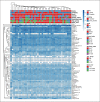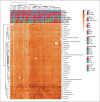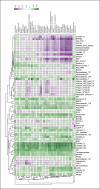The Human Salivary Antimicrobial Peptide Profile according to the Oral Microbiota in Health, Periodontitis and Smoking
- PMID: 30485856
- PMCID: PMC6738235
- DOI: 10.1159/000494146
The Human Salivary Antimicrobial Peptide Profile according to the Oral Microbiota in Health, Periodontitis and Smoking
Abstract
Antimicrobial peptides (AMPs) are a diverse family of peptides that defend the mucosal surfaces of the oral cavity and other locations. Many AMPs have multiple functions and properties that influence aspects of innate defense and colonization by microorganisms. The human oral cavity is home to the second-most diverse microbiome, and the health of the mouth is influenced by the presence of these bacteria as well as by extrinsic factors such as periodontitis and smoking. This study hypothesized that the AMP profile is different in the presence of extrinsic factors and that this would also be reflected in the bacteria present. The AMP profile was analyzed by quantitative selected-reaction-monitoring mass spectrometry analysis and 40 bacterial species were quantified by DNA-DNA hybridization in saliva donated by 41 individuals. Periodontal status was assessed through dental examination and smoking status through medical charting. Periodontal health (in nonsmokers) was associated with a higher abundance of ribonuclease 7, protachykinin 1, β-defensin 128, lipocalin 1, bactericidal permeability-increasing protein fold-containing family B member 3, and bone-marrow proteoglycan. Nonsmoking periodontal disease was associated with an abundance of neutrophil defensin 1 and cathelicidin. However, 7 AMPs were overabundant in periodontal disease in smokers: adrenomedullin, eosinophil peroxidase, 3 different histones, myeloperoxidase, and neutrophil defensin 1. There were no differentially abundant AMPs in smokers versus nonsmokers with periodontal health. Correlation network inference of healthy nonsmokers, healthy smokers, nonsmoking periodontitis, or smoking periodontitis donors demonstrated very different networks growing in complexity with increasing numbers of stressors. The study highlights the importance of the interaction between the oral cavity and its resident microbiota and how this may be influenced by periodontal disease and smoking.
Keywords: Antimicrobial peptides; Inflammation; Periodontitis; Saliva.
© 2018 The Author(s) Published by S. Karger AG, Basel.
Conflict of interest statement
All authors declare no conflicts of interest.
Figures




Similar articles
-
Effects of periodontitis and smoking on the microbiota of oral mucous membranes and saliva in systemically healthy subjects.J Clin Periodontol. 2003 Dec;30(12):1031-7. doi: 10.1046/j.0303-6979.2003.00418.x. J Clin Periodontol. 2003. PMID: 15002888
-
Salivary human beta-defensins and cathelicidin levels in relation to periodontitis and type 2 diabetes mellitus.Acta Odontol Scand. 2020 Jul;78(5):327-331. doi: 10.1080/00016357.2020.1715471. Epub 2020 Jan 24. Acta Odontol Scand. 2020. PMID: 31980002
-
High-Throughput Combined Analysis of Saliva Microbiota and Metabolomic Profile in Chinese Periodontitis Patients: A Pilot Study.Inflammation. 2024 Jun;47(3):874-890. doi: 10.1007/s10753-023-01948-6. Epub 2023 Dec 26. Inflammation. 2024. PMID: 38148454
-
Antimicrobial peptides in periodontal innate defense.Front Oral Biol. 2012;15:84-98. doi: 10.1159/000329673. Epub 2011 Nov 11. Front Oral Biol. 2012. PMID: 22142958 Free PMC article. Review.
-
Oral microbiota-induced periodontitis: a new risk factor of metabolic diseases.Rev Endocr Metab Disord. 2019 Dec;20(4):449-459. doi: 10.1007/s11154-019-09526-8. Rev Endocr Metab Disord. 2019. PMID: 31741266 Review.
Cited by
-
The Impact of Vitamin Deficiencies on Oral Manifestations in Children.Dent J (Basel). 2024 Apr 17;12(4):109. doi: 10.3390/dj12040109. Dent J (Basel). 2024. PMID: 38668021 Free PMC article. Review.
-
Evaluation of Antimicrobial Peptides in Saliva as Potential Therapeutic Agents Against Oral Pathogens in Pakistan.Cureus. 2024 Nov 15;16(11):e73758. doi: 10.7759/cureus.73758. eCollection 2024 Nov. Cureus. 2024. PMID: 39677072 Free PMC article.
-
Mass Spectrometry-Based Proteomics for Discovering Salivary Biomarkers in Periodontitis: A Systematic Review.Int J Mol Sci. 2023 Sep 27;24(19):14599. doi: 10.3390/ijms241914599. Int J Mol Sci. 2023. PMID: 37834046 Free PMC article.
-
Salivary bactericidal/permeability-increasing protein: A novel inflammatory marker associated with periodontitis.Clin Oral Investig. 2023 Jun;27(6):3159-3167. doi: 10.1007/s00784-023-04922-6. Epub 2023 Feb 20. Clin Oral Investig. 2023. PMID: 36805805
-
Human host defence peptide LL37 and anti-cyclic citrullinated peptide antibody in early inflammatory arthritis.RMD Open. 2019 Apr 29;5(1):e000874. doi: 10.1136/rmdopen-2018-000874. eCollection 2019. RMD Open. 2019. PMID: 31245047 Free PMC article.
References
-
- Dennesen P, van der Ven A, Vlasveld M, Lokker L, Ramsay G, Kessels A, et al. Inadequate salivary flow and poor oral mucosal status in intubated intensive care unit patients. Crit Care Med. 2003 Mar;31((3)):781–6. - PubMed
-
- Mandel ID. The role of saliva in maintaining oral homeostasis. J Am Dent Assoc. 1989 Aug;119((2)):298–304. - PubMed
-
- Gorr SU, Abdolhosseini M. Antimicrobial peptides and periodontal disease. J Clin Periodontol. 2011 Mar;38(Suppl 11):126–41. - PubMed
-
- Pütsep K, Carlsson G, Boman HG, Andersson M. Deficiency of antibacterial peptides in patients with morbus Kostmann: an observation study. Lancet. 2002 Oct;360((9340)):1144–9. - PubMed
-
- Jönsson D, Nilsson BO. The antimicrobial peptide LL-37 is anti-inflammatory and proapoptotic in human periodontal ligament cells. J Periodontal Res. 2012 Jun;47((3)):330–5. - PubMed
Publication types
MeSH terms
Substances
LinkOut - more resources
Full Text Sources
Other Literature Sources
Research Materials

